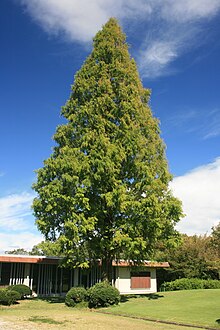
Back Metasekvoya Azerbaijani Vandgran-slægten Danish Μετασεκόια Greek Metasekvoia (perekond) Estonian Kiinanpunapuut Finnish Metasequoia Hungarian Kayu merah fajar ID Metasequoia Icelandic 메타세쿼이아속 Korean Metasekvoja Lithuanian
| Metasequoia Temporal range:
| |
|---|---|

| |
| Metasequoia glyptostroboides | |
| Scientific classification | |
| Kingdom: | Plantae |
| Clade: | Tracheophytes |
| Clade: | Gymnospermae |
| Division: | Pinophyta |
| Class: | Pinopsida |
| Order: | Cupressales |
| Family: | Cupressaceae |
| Subfamily: | Sequoioideae |
| Genus: | Metasequoia Hu & Cheng |
| Type species | |
| Metasequoia glyptostroboides Hu & Cheng
| |
| Species | |
Metasequoia, or dawn redwood, is a genus of fast-growing coniferous trees, one of three species of conifers known as redwoods. The living species Metasequoia glyptostroboides is native to Lichuan county in Hubei province, China. Although the shortest of the redwoods, it grows to at least 165 feet (50 meters) in height. Local villagers refer to the original tree from which most others derive as Shuǐshān (水杉), or "water fir", which is part of a local shrine. Since its rediscovery in 1944, the dawn redwood has become a popular ornamental, with examples found in various parks in a variety of countries.
Together with Sequoia sempervirens (coast redwood) and Sequoiadendron giganteum (giant sequoia) of California, Metasequoia is classified in the Cupressaceae subfamily Sequoioideae. M. glyptostroboides is the only living species in its genus, but three fossil species are known. Sequoioideae and several other genera have been transferred from the former family Taxodiaceae to Cupressaceae based on DNA analysis.[1]
- ^ Gadek, Paul A.; Alpers, Deryn L.; Heslewood, Margaret M.; Quinn, Christopher J. (2000). "Relationships within Cupressaceae sensu lato: a combined morphological and molecular approach". American Journal of Botany. 87 (7): 1044–1057. doi:10.2307/2657004. JSTOR 2657004. PMID 10898782.